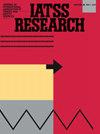Unpacking the relationship between task complexity and driving risk: Insights from a UK on-road trial
IF 3.3
Q3 TRANSPORTATION
引用次数: 0
Abstract
This study investigates the intricate relationship between task complexity and driving risk through a comprehensive four-phase on-road trial conducted in the UK. Employing Structural Equation Modelling (SEM), the research illuminates the factors influencing task complexity and its association with risk, treating both as latent concepts—unobservable variables in the study. The findings reveal a notable positive correlation between task complexity and risk, particularly concerning the headway indicator. In essence, the study demonstrates that an escalation in task complexity corresponds to an increased level of risk.
Throughout the four SEM analyses performed across two waves of on-road trials, the time spent in each safety tolerance zone level for headway measurements emerges as a key indicator of the latent construct of risk in all phases. Notably, the variables constituting the latent concept of task complexity—those proven statistically significant—show slight variations across phases. Variables consistently significant across all phases include the number of right Lane Departure Warnings (LDWs) per 30 s and the day of the week.
The models reveal the feasibility of quantifying the risk-task complexity relationship in real-world driving settings. This study provides insights to inform efforts to mitigate risk exposure through design and training interventions, targeting the most predictive factors linked to task complexity. Driver demographics did not emerge as statistically significant, emphasising the need for a holistic approach to improve road safety.
解开任务复杂性和驾驶风险之间的关系:来自英国道路试验的见解
本研究通过在英国进行的一项全面的四阶段道路试验,调查了任务复杂性和驾驶风险之间的复杂关系。本研究采用结构方程模型(SEM),阐明了影响任务复杂性的因素及其与风险的关系,并将两者视为潜在概念-研究中的不可观察变量。研究结果显示,任务复杂性和风险之间存在显著的正相关关系,特别是在车头时距指标方面。从本质上讲,这项研究表明,任务复杂性的升级对应于风险水平的增加。在两波道路试验中进行的四次扫描电镜分析中,车头时距测量在每个安全容忍区水平上花费的时间成为所有阶段潜在风险构建的关键指标。值得注意的是,构成任务复杂性潜在概念的变量——那些被证明具有统计学意义的变量——在不同阶段表现出轻微的变化。在所有阶段中,重要的变量包括每30秒和一周中的哪一天发出的右车道偏离警告(ldw)的次数。这些模型揭示了在现实驾驶环境中量化风险-任务复杂性关系的可行性。这项研究为通过设计和培训干预措施来降低风险暴露的努力提供了见解,目标是与任务复杂性相关的最可预测因素。驾驶员的人口统计数据在统计上并不显著,这强调了需要采取整体方法来改善道路安全。
本文章由计算机程序翻译,如有差异,请以英文原文为准。
求助全文
约1分钟内获得全文
求助全文
来源期刊

IATSS Research
TRANSPORTATION-
CiteScore
6.40
自引率
6.20%
发文量
44
审稿时长
42 weeks
期刊介绍:
First published in 1977 as an international journal sponsored by the International Association of Traffic and Safety Sciences, IATSS Research has contributed to the dissemination of interdisciplinary wisdom on ideal mobility, particularly in Asia. IATSS Research is an international refereed journal providing a platform for the exchange of scientific findings on transportation and safety across a wide range of academic fields, with particular emphasis on the links between scientific findings and practice in society and cultural contexts. IATSS Research welcomes submission of original research articles and reviews that satisfy the following conditions: 1.Relevant to transportation and safety, and the multiple impacts of transportation systems on security, human health, and the environment. 2.Contains important policy and practical implications based on scientific evidence in the applicable academic field. In addition to welcoming general submissions, IATSS Research occasionally plans and publishes special feature sections and special issues composed of invited articles addressing specific topics.
 求助内容:
求助内容: 应助结果提醒方式:
应助结果提醒方式:


